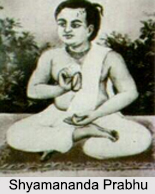 Shyamananda Prabhu was a Vaishnava saint, who was the disciple of Hridayananda or Hriday Chaitanya. He was the member of the second expansion of Mahaprabhu Chaitanya along with Srinivasa Acharya and Narottama Das Thakur. They served in preaching the doctrine of Vaishnavism of Chaitanya. Shyamananda was known as Hridayananda"s dear disciple.
Shyamananda Prabhu was a Vaishnava saint, who was the disciple of Hridayananda or Hriday Chaitanya. He was the member of the second expansion of Mahaprabhu Chaitanya along with Srinivasa Acharya and Narottama Das Thakur. They served in preaching the doctrine of Vaishnavism of Chaitanya. Shyamananda was known as Hridayananda"s dear disciple.
Life of Shyamananda Prabhu
Shyamananda was born on the month of Chaitra in 1456 of the Shaka era in Dharenda Bahadurpura, Medinipur. His father was Sri Krishna Mandal and mother was Durika. Shyamananda Prabhu belonged to the Sadgopa subcaste, which falls in the category of "jala-cala"- Brahmins were allowed to take water touched by them. Shyamananda was called Duhkhi in his childhood. When Hriday Chaitanya gave him the Krishna Mantra, then he was named Duhkhi Krishna Das. During his time in Vrindavana, Shyamananda Prabhu was completely absorbed in the devotion of Radha and Krishna. In Vrindavana, he studied the Vaishnava scriptures under Jiva Goswami, who was the leading scholar of the Sampradaya. Jiva Goswami gave titles to his three prominent disciples- Srinivasa, Narottama and Duhkhi Krishna Das. He gave the name Shyamananda later. Jiva Goswami sent his three disiples back to Bengal with Vaishnava scriptures in 1504 of Shaka era to spread the teachings of Chaitanya Mahaprabhu in all over the regions of Bengal and Odisha. Shyamananda died on the month of Asharah in 1552 of Shaka era.
Shyamananda as Disciple
Though Shyamananda was the first guru of him, his guru had entrusted him to the care of Jiva Goswami Prabhu. He was also the disciple of Gauri Das Pandit, who was one of the twelve Gopals of Subala Sakha. Shyamananda was also very close to Radharani in Vrindavan. One day he found her ankle bracelet on the ground so he touched it to his forehead, where it left a mark. This day is marked as the "tilaka" marking of the disciples of Shyamananda"s descendants. It is known as "nupura-tilaka".
Shyamananda"s Style of Preaching
Initially Narottama, Srinivasa and Shyamananda started to preach Chaitanya"s message through Kirtan. Srinivasa sang Kirtan in a style named "Manohara-sahi", Narottama in "Gariana-hati" and Shyamananda in "Reneti". These styles of Kirtan no longer exist. By this style of preaching, many Muslims of Odisha became Shyamananda"s disciples. The most prominent disciple of him was Rasika Murari, who was the son of Achyutananda. Shyamananda had his disciples in all over Bengal and Odisha. Along with this, Shyamananda also converted a yogi named Damodar.
Contributions of Shyamananda
Shyamananda also started a festival at Dharendra with Rasika Murari and Damodar, which is still celebrated today. Shyamananda turned over the service of Govinda at Gopivallabhapura. His disciples and descendants still worship Shyamananda"s deity Radha-Shyamasundar in Vrindavan. The temple is one of the principle pilgrimage sites in Vrindavan. Shyamananda lived his old age in Nrisinghapura in Odisha where he continued to preach Vaishnavism.




















